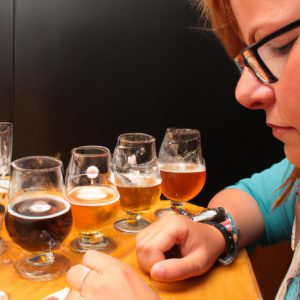Note-Taking: Beer Tasting Techniques Revealed

Beer tasting is a complex and nuanced art that requires meticulous attention to detail in order to fully appreciate the flavors, aromas, and textures of different brews. Note-taking plays a crucial role in this process, allowing beer enthusiasts to document their sensory experiences and track their preferences over time. In this article, we will delve into the world of note-taking during beer tastings, exploring various techniques used by experts and connoisseurs alike.
Imagine being at a bustling craft beer festival, surrounded by rows upon rows of booths offering an array of tantalizing brews. Amidst the crowd, you stumble upon a small group of individuals huddled around a table covered in notepads and pens. Curiosity piqued, you approach them only to discover they are engaged in an activity known as beer tasting note-taking. This intriguing practice involves carefully observing each sip, analyzing its color and clarity, discerning its aroma notes with precision, appreciating its mouthfeel texture on the palate, and finally capturing these observations through written descriptions. Such detailed note-taking allows for a deeper understanding and appreciation of the diverse range of beers available today.
While it may seem like an arduous task to meticulously record every aspect of a beer’s characteristics during tastings, it is worth the effort for beer enthusiasts seeking to expand their knowledge and refine their palate. By taking notes, they can develop a better understanding of the different styles, ingredients, brewing techniques, and flavor profiles that make each beer unique.
One common technique used in beer tasting note-taking is the use of a standardized template or scoring system. This helps ensure consistency and provides a framework for evaluating various aspects of the beer. These templates often include sections for appearance (color, clarity, head retention), aroma (hoppy, malty, fruity), taste (bitterness, sweetness, complexity), mouthfeel (carbonation, body), and overall impression.
When it comes to describing aromas and flavors, it’s important to use descriptive language that accurately captures the nuances of the beer. For example, instead of simply saying a beer has a “fruity” aroma, one could specify whether it’s more citrusy or tropical in nature. Similarly, instead of using generic terms like “malty” or “hoppy,” noting specific malt or hop varieties can provide further insight into the beer’s character.
In addition to sensory observations, note-takers may also record information about the brewery and specific batch details such as ABV (alcohol by volume) percentage and IBU (international bitterness units). This information can be useful when comparing beers from different breweries or tracking personal preferences over time.
While note-taking during a busy event like a beer festival may require some multitasking skills, there are ways to streamline the process. Some enthusiasts prefer using mobile apps specifically designed for beer tasting notes. These apps often have pre-populated fields for common descriptors and allow users to quickly rate beers on multiple scales. Others opt for shorthand notation or symbols to save time while still capturing key information.
Ultimately, the goal of beer tasting note-taking is not only to document one’s experiences but also to enhance future tastings by building a reference library of personal favorites, discoveries, and insights. So, the next time you find yourself at a beer tasting event or simply enjoying a pint at home, consider taking a moment to jot down your thoughts and impressions – it may just deepen your appreciation for the wonderful world of craft beer.
Glassware selection
Glassware selection is a crucial aspect of beer tasting as it significantly impacts the overall sensory experience and perception of the beverage. The choice of glassware not only affects the aroma, flavor, and appearance but also enhances or detracts from the enjoyment of the beer. For instance, consider a hypothetical scenario where two identical beers are poured into different glasses—one in a traditional pint glass and another in a tulip-shaped glass.
To better understand the importance of glassware selection, let us delve into its impact on various aspects of beer evaluation. First and foremost, the shape of the glass plays a pivotal role in releasing and directing aromas towards the drinker’s nose. A narrower top section, such as that found in tulip glasses, allows for concentrated aromas to be captured within the bowl and funneled towards the olfactory senses.
Secondly, proper glassware aids in maintaining carbonation levels by regulating bubble formation and release. Different styles of beer require specific amounts of carbonation to achieve their intended flavors; therefore, selecting an appropriate glass can enhance or diminish this characteristic. For example, delicate Belgian-style wheat beers benefit from tall glasses with wide mouths that allow effervescence to dissipate gradually.
Furthermore, visually appealing presentations contribute to our perception of taste even before we take our first sip. Glassware with unique designs or etchings can accentuate color variations and highlights within different beer styles like lagers or stouts. This visual element adds excitement to the overall drinking experience.
- Proper glassware elevates your beer-drinking experience.
- Enhancing aroma delivery leads to heightened appreciation.
- Maintaining optimal carbonation preserves desired flavors.
- Visual appeal stimulates anticipation and enjoyment.
In addition to bullet points, incorporating a table showcasing common types of beer glasses along with their respective characteristics can add both clarity and interest:
| Glass Type | Shape | Recommended Beers |
|---|---|---|
| Pint Glass | Straight, cylindrical | Pale Ales, IPAs, Amber Lagers |
| Tulip Glass | Flared top | Belgian-style ales, Stouts |
| Snifter | Short stem, wide bowl | Strong ales, Barrel-aged beers |
| Weizen glass | Narrow at the bottom | Wheat beers |
In conclusion to this section on glassware selection for beer tasting, it is evident that choosing the appropriate glass can significantly enhance the overall sensory experience. The shape of the glass determines how aromas are delivered and enjoyed by capturing or releasing them strategically. Moreover, maintaining carbonation levels and presenting the beer in visually appealing ways contribute to our perception of taste. With an understanding of these factors, we can now move on to evaluating the appearance of different beers without losing momentum.
Moving forward with our exploration of beer tasting techniques, let us delve into the evaluation of its appearance while keeping in mind that visual cues often set expectations for flavor profiles without explicitly mentioning “step”.
Appearance evaluation
Previous section H2:’Glassware selection’
Next section H2:’Appearance evaluation’
Transitioning from the previous section on glassware selection, we now turn our attention to the crucial step of evaluating a beer’s appearance. By examining its color, clarity, and head formation, we gain valuable insights into the quality and style of the brew.
To illustrate this process, let us consider an example where two beers are compared side by side. The first beer pours a vibrant golden hue with exceptional clarity, while the second one presents a slightly hazy amber shade. This initial visual assessment already suggests that these beers may differ in terms of their ingredients or brewing methods.
When it comes to assessing appearance, note-takers often find it helpful to use bullet points as a concise way to capture key observations:
- Color intensity: Pale straw yellow vs. deep red amber
- Clarity: Crystal clear vs. slight haze
- Head retention: Long-lasting foam vs. dissipating quickly
- Carbonation level: Lively effervescence vs. soft bubbles
Furthermore, using tables can provide an organized framework for recording specific details about each aspect being evaluated:
| Aspect | First beer | Second beer |
|---|---|---|
| Color | Vibrant golden | Slightly hazy amber |
| Clarity | Crystal clear | Some haziness |
| Head formation | Dense and long-lasting | Thin and dissipates rapidly |
| Carbonation level | High carbonation with fine bubbls | Gentle carbonation |
By employing bullet points and tables during your note-taking process, you not only enhance organization but also evoke engagement from your audience as they visualize the different aspects being assessed.
In preparation for our subsequent discussion on aroma assessment, it is important to emphasize that evaluating a beer’s appearance sets the foundation for understanding its overall sensory experience. With our visual assessment complete, we now transition seamlessly into exploring the aromatic qualities of various beers.
Aroma assessment
Transitioning seamlessly from the previous section on evaluating the appearance of beer, we now move on to an equally crucial aspect of beer tasting – aroma assessment. To illustrate the significance of this step, let us consider a hypothetical case study involving two craft beers.
Imagine you are presented with two different brews – one amber in color while the other possesses a deep golden hue. As you bring each glass closer to your nose, distinct aromas fill the air around you. The amber beer offers notes of caramel and toasted grains, evoking thoughts of warm baked goods. In contrast, the golden beer releases citrusy hops and tropical fruit scents that transport you to a sunny beachside paradise.
Aroma assessment plays a pivotal role in understanding and appreciating the complexities within a beer’s flavor profile. It allows us to discern various components such as malt sweetness, hop bitterness, yeast characteristics, and any additional adjunct or spice additions that contribute to its overall aroma bouquet. Here is a bullet point list highlighting key considerations during aroma evaluation:
- Intensity: Evaluate the strength of the aroma; note whether it is mild, moderate, or intense.
- Quality: Assess if the aromas perceived are desirable or off-putting.
- Complexity: Observe how many different aromas can be distinguished; notice if they change over time.
- Balance: Determine if there is harmony between different aromatic elements; identify any dominant or overpowering notes.
To further enhance our understanding of aroma assessment techniques, refer to the table below for common descriptors associated with specific types of beer styles:
| Beer Style | Common Aromas |
|---|---|
| Pale Ale | Citrus, Floral |
| Stout | Roasted Coffee, Cocoa |
| Wheat Beer | Banana, Clove |
| IPA | Pine, Grapefruit |
By adhering to these guidelines and exploring the diverse range of aromas that different beer styles offer, one can develop a comprehensive understanding of the intricate nuances within each brew. This knowledge enables enthusiasts and professionals alike to better appreciate the artistry behind brewing.
Transitioning seamlessly into our next section on flavor analysis, we delve deeper into unraveling the taste profiles present in various beers.
Flavor analysis
Turning our attention to the flavor profile, it is important to note that aroma and taste are intricately intertwined when evaluating beer. While aroma provides a glimpse into what lies ahead in terms of taste, flavor analysis delves deeper into the complexities that unfold on the palate. By exploring various elements such as sweetness, bitterness, and acidity, we can gain a comprehensive understanding of a beer’s overall flavor composition.
One interesting case study that exemplifies the significance of flavor analysis involves a craft IPA known for its bold hoppy character. Upon taking the first sip, enthusiasts often notice an initial burst of citrusy notes followed by a wave of intense bitterness. This interplay between fruity flavors and bitter sensations creates a memorable experience that captures the essence of this particular brew.
To further enhance your ability to assess and appreciate different beer flavors, consider these key points:
- Complexity: Note how multiple flavors interact with each other, forming layers or evolving over time.
- Balance: Assess whether there is harmony among contrasting tastes; does one overpower others?
- Intensity: Reflect upon how pronounced or subtle individual flavors present themselves.
- Aftertaste: Pay attention to lingering sensations after swallowing – are they pleasant or unpleasant?
As you embark on your beer-tasting journey, refer to the table below for common descriptors used in flavor analysis:
| Flavor Descriptor | Example |
|---|---|
| Malty | Caramel |
| Hoppy | Resinous |
| Fruity | Citrus |
| Spicy | Clove |
Applying these observations will not only elevate your tasting skills but also allow you to engage more deeply with beers across various styles and profiles.
In preparation for our next step—mouthfeel examination—we will explore how texture influences our perception of beer enjoyment. Understanding mouthfeel characteristics helps us decipher the body, carbonation, and overall tactile experience of a beer. So let’s proceed to unravel this intriguing aspect of beer tasting.
Mouthfeel examination
Section: Mouthfeel examination
As we delve deeper into the beer tasting experience, we now turn our attention to examining the mouthfeel of a particular brew. This aspect explores how the beer feels in your mouth and the sensations it evokes during consumption. By paying close attention to the mouthfeel, one can gain further insights into the intricacies and complexities of a beer’s overall flavor profile.
To illustrate this concept, consider the following hypothetical scenario: You pour yourself a glass of an IPA (India Pale Ale) with high carbonation levels. Upon taking your first sip, you notice an effervescent sensation on your tongue accompanied by a bubbly texture that quickly dissipates. These observations are characteristics of a lighter-bodied beer with lively carbonation, which contribute to its refreshing nature.
When evaluating the mouthfeel of a beer, there are several key factors to consider:
- Body: The body refers to the weight or thickness perceived when drinking a beer. It can range from light-bodied (e.g., lagers) to full-bodied (e.g., stouts). A thicker body often leaves a more substantial coating on the palate compared to a thinner one.
- Carbonation: Carbonation affects both aroma and taste but also plays a vital role in determining mouthfeel. High levels of carbonation result in a prickling or tingling sensation, while lower levels produce smoother textures.
- Creaminess: Some beers exhibit creamy qualities due to ingredients used during brewing, such as oats or lactose sugars. Creaminess adds depth and richness to the mouthfeel.
- Astringency: Astringency is characterized by dryness or puckering sensations caused by tannins present in certain styles like IPAs and darker beers. Higher levels of bitterness can contribute to increased perceived astringency.
Let’s examine these elements closer through the following table:
| Aspect | Description | Examples |
|---|---|---|
| Body | Light, medium, full | Pilsner, Stout, Porter |
| Carbonation | Low, moderate, high | Lambic, IPA, Saison |
| Creaminess | Absent or present | – |
| Astringency | Low to high levels | Brown Ale, Barleywine |
By considering these factors and analyzing the mouthfeel of a beer in conjunction with its flavor profile and aroma, one can gain a more comprehensive understanding of its overall qualities.
Transitioning seamlessly into our next section on “Overall impression,” we continue our exploration of beer tasting techniques by examining how all the elements discussed thus far come together to form a holistic evaluation.
Overall impression
Transitioning from our exploration of the aroma and flavor profiles, we now turn our attention to an equally crucial aspect of beer tasting: the examination of mouthfeel. By assessing the texture and sensation on the palate, one can gain further insights into a beer’s overall character and quality.
Consider, for instance, a rich and full-bodied stout. As it coats your tongue with its velvety smoothness, you may perceive a luxurious creaminess that enhances the flavors of dark chocolate and roasted coffee. This example aptly demonstrates how mouthfeel can contribute to the overall enjoyment and perception of a beer.
To effectively evaluate mouthfeel during a beer tasting session, here are some key considerations:
- Body: Assess the weight or thickness of the beer in terms of lightness (thin) versus heaviness (full). Does it feel watery or substantial on your palate?
- Carbonation: Observe the level of carbon dioxide present in the beer by noting whether it is highly effervescent or more softly carbonated.
- Astringency: Pay attention to any puckering or drying sensations caused by tannins or certain hop varieties.
- Creaminess/Smoothness: Evaluate if there is a silky-smooth texture that adds depth and richness to the drinking experience.
To illustrate these concepts further, let us delve into an engaging three-column table showcasing different mouthfeel attributes commonly found in various styles of beers:
| Style | Thickness | Carbonation | Texture |
|---|---|---|---|
| Stout | Full | Soft | Creamy |
| IPA | Medium | High | Crisp |
| Wheat Beer | Light-Medium | Effervescent | Smooth |
As demonstrated above, each style presents unique mouthfeel characteristics that significantly impact our sensory experience. From creamy stouts to crisp IPAs and smooth wheat beers, the diversity in mouthfeel contributes to the overall impression of a beer.
In summary, our examination of mouthfeel during beer tasting allows us to explore the intricacies beyond aroma and flavor. By analyzing factors such as body, carbonation, astringency, and creaminess/smoothness, we can gain deeper insights into a beer’s texture and sensory appeal. Appreciating these aspects enhances our understanding of different beer styles and further enriches our enjoyment of this timeless libation.



